QuestionQUESTION: We have a 5 MOS old puppy. He is aprox 35lbs. Soon after we brought him home at weeks he developed an inflammation in his intestines (despite being dewormed prior to us bringing him home) We had a difficult time getting him off of the "bland" diet the vet prescribed without his diarrhea developing again. I also had a difficult time getting any answers on which dog food to start him on. I chose Purina Pro Plan adult food for sensitive stomach its main ingredient is salmon and the other foods I tried (Premium Edge, Wellness all had Lamb which I thought might be too rich for him) I looked into RoyalCanin but I was confused with the Chicken by product being the first ingredient.
Anyway, despite the fact he is growing well....his mannerism when eating is to inhale the food in like seconds (literally) I have tried to stop him...making him sit and wait but he can only hold out so long. Is this just his way of eating from being sick earlier? or should I reevaluate the food I have chosen? I am feeding him 3x per day (and beginning to transition to 2x/day) two cups at each meal (not the lunch meal that I am phasing out) When I fed him 3x per day it was 1 1/2 cups at each feeding. Is this too little?
I know this is a long question. I do appreciate any information you can provide. I have had little answers even from my vet.
Thank you
ANSWER: Inhaling food is much more common in Labs and Goldens than Shepherds. Some of them are tough to get to eat enough to hid their ribs. There are not one, but 2 easy, tested, effective ways to control rapid eating. You can spread the food out on a cookie sheet or something. Some of my friends just throw it on the floor of the crate. You can put large rocks in the food dish, much to big to swallow. Either way, the dog can't gulp down one big mouthful after another.
I am glad you are feeding an adult chow. It will slow his growth allowing more time to develop sturdy joints. Just make sure he doesn't eat too much, again usually not a Shepherd problem. Your dog definitely should be narrower at the waist than the hips and chest. You should be able to easily feel the ribs, but not see them. Each dog is different. Standard recommendations are a good place to start, but each dog must have its food and exercise adjusted to its individual needs. Here is a link to a good illustrated guide, http://www.longliveyourdog.com/twoplus/RateYourDog.aspx 4 1/2 cups sound high to me, but the final word is how his ribs feel. 2 meals a day is fine now. I cut my puppies back to 1 at 6 months, but with his past problems, you may want to go with 2 longer.
As far as I know, the Pro Plan you are feeding is as good as anything. Much of what you read about dog chow is all speculation with only marketing hype backing it, not science. Many of the strong statements as fact that you read may be based on one person's experience with one dog.
I am disappointed your vet hasn't been more helpful. Of course, many of them aren't up on the junk science so common on the net.
Often it is easier for me to give better answers if the question gives all the important details.
---------- FOLLOW-UP ----------
QUESTION: I forgot to ask you another question about portable fences.
It is like an underground fence except it is portable and it does continue to shock them when they leave the parameter until they come back in (one reason I don't like it) and the salesman said we should wait until he is a year old because it can affect their nervous system. I don't want to do any harm to him and I do understand we can train him to stay in our yard but we do have a busy road in front of our house and I wanted more protection for him. Have you any experience with these types of fences and do they harm the dogs nervous system?
Thank you for your answer to my last question. I feel so much better knowing I picked the right food for him. I honestly read all the labels carefully. The ProPlan seems to work for him. However, I am finding that he is verys sensitive to any deviation. I have been giving him treats and Puppy Kong and it has made his stool soft. So now I am stopping that. I guess his treats will be his kibble.
Thanks again!
Answerthere is nothing wrong with using the kibble as treats. You might try ice cubes too.
I am not familiar with that portable fence system. When a salesman warns you of a problem with his product, likely you should heed it. too often they gloss over or ignore problems.
"Come" needs to be taught as part of proper pack status and obedience. The dogs see all the people and dogs in the household as a pack with each having their own rank in the pack and a top dog. Life is much easier if the 2 legged pack members outrank the 4 legged ones. You can learn to play the role of top dog by reading some books or going to a good obedience class. Start at http://www.dogsbestfriend.com/.
If you dog is at least 4 - 5 months old, start with a good 6' leather leash and a sturdy slip collar, the metal chain ones with the rings on each end. You want the shortest one that will go on and off easily. If you walk with the dog on the left, pull the chain through one loop forming a "P". Facing it, slip it over its head. The free end should come over the neck to the leash, and the other end should drop slack when there is no pull on the leash. Before 4 months use a conventional flat collar to protect the tender young neck.
With the dog at the end of the leash, call its name and "Come" in a firm voice. If it comes, praise it lavishly and pet it. If it doesn't come, repeat the command and give the leash a light snap. Keep it up with firmer leash snaps until the dog does come. Do not forget the praise. Then switch to a longer leash or rope, about 25'. When it comes well on the longer leash, you should be able to go to off leash in a fenced area, etc. Once the dog is doing well, introduce come, treat. This is for emergencies only when the dog has gotten loose accidentally. Use it routinely and you will have nothing to fall back on when your dog is headed for a busy street. "Name, come treat!" is little different from the regular "Name, come!", except the dog gets a great treat when it comes. We are talking a hot dog, cheese, etc. much better than any treat you use routinely.
Relying on come to control most dogs loose outside is risky, and I do not recommend it. Dogs are individuals. Some can be trained to come when you have no way to enforce it, but some will never be completely reliable even for the most experienced trainers.
A tether is fine for short relief breaks with exercise coming from long walks on leash or in controlled areas like a dog park. That was all we had for years and I still use one when I am working in the unfenced fron yard.

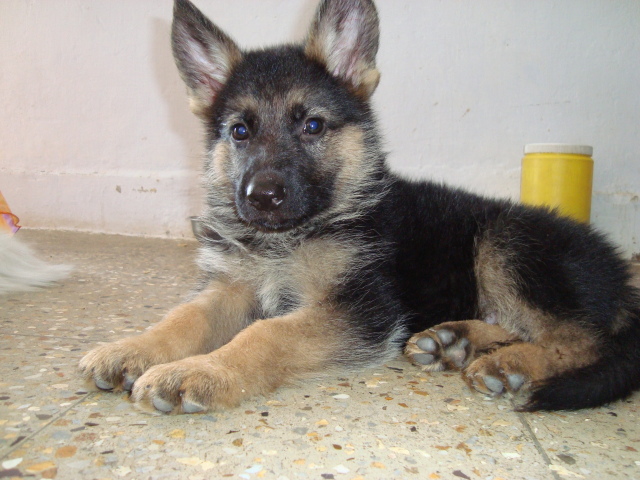 puppy weight
Question
Rocky
I recently purchase 2 mnths old GS puppy
puppy weight
Question
Rocky
I recently purchase 2 mnths old GS puppy
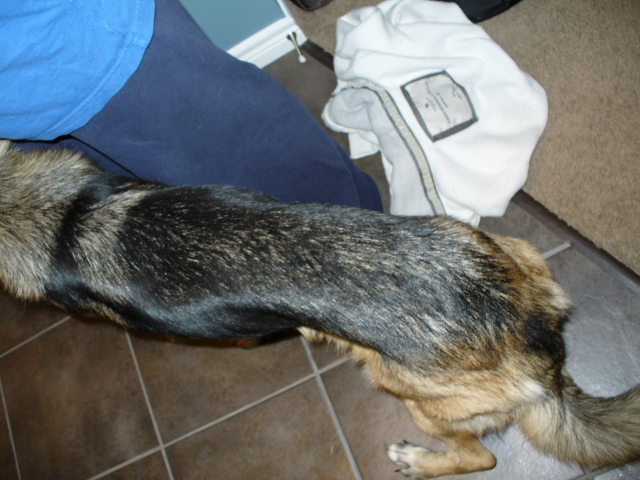 Very thin German Shepherd
Question
Sadie
Hi
We are having problems getting our
Very thin German Shepherd
Question
Sadie
Hi
We are having problems getting our
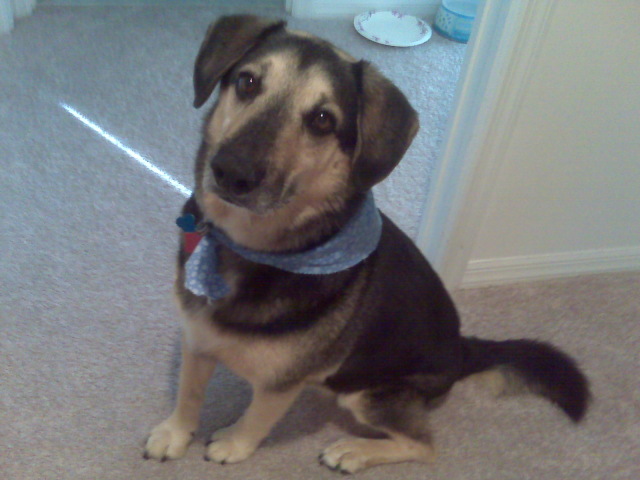 German Shepherd Mix Food
Question
Harley
Hello,
I have a 6 1/2 year old German S
German Shepherd Mix Food
Question
Harley
Hello,
I have a 6 1/2 year old German S
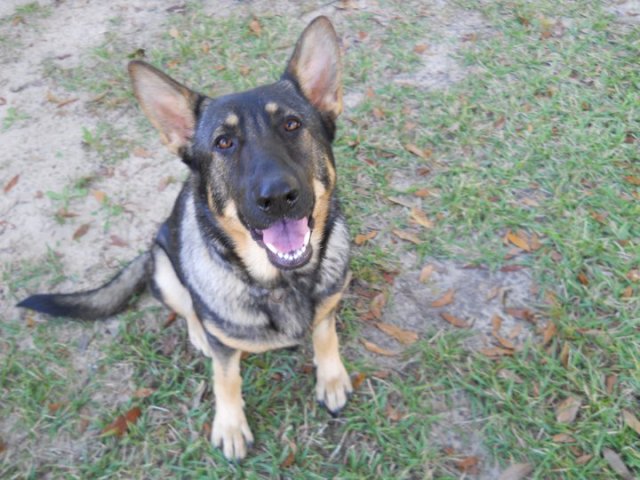 Training rescued German Shepherd
Question
Libby
My boyfriend and I have recently took in
Training rescued German Shepherd
Question
Libby
My boyfriend and I have recently took in
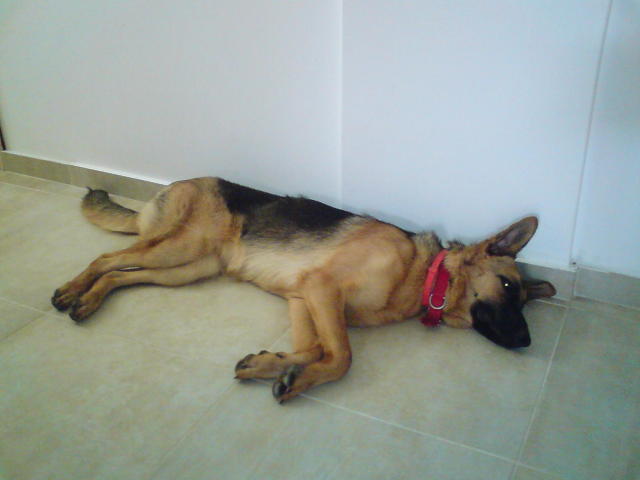 puppy growing thin and tall
Question
Lying down
Hi, I have a 9 month old German She
puppy growing thin and tall
Question
Lying down
Hi, I have a 9 month old German She